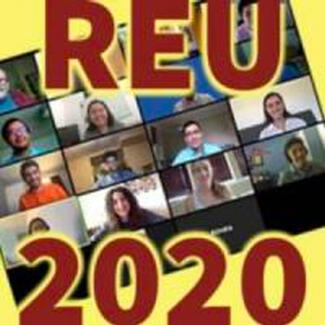
It’s a Wrap! EE’s Undergrad Researchers ready to present Thursday
Join us Thursday for the Research Experience for Undergraduates (REU) 2020 poster session presentations.
Congratulations to the 26 undergraduate students who participated in Electrical Engineering's Research Experience for Undergraduates (REU) program, 2020. Students worked remotely to participate in their selected research projects. Faculty advisors and graduate student mentors met with and guided the program participants during research team meetings and one on one. The undergraduate researchers also attended weekly seminars featuring faculty, industry experts, and a graduate student panel to explore advanced degrees and research.
Thursday will be the student’s final presentations, demonstrating their findings. The community is invited to attend. 2020’s research projects are grouped into three main areas: circuits and physical systems, signals and information systems, and materials and devices.
The project and researchers are listed below in order of presentation.
Please email reu@ee.stanford.edu if you have questions, or plan to attend the event (password is required).

Research Experience for Undergraduates (REU) program participants 2020
[Photo credit: Marisa Cheng]
CIRCUITS AND PHYSICAL SYSTEMS
1. Understanding and Measuring Troubleshooting Ability in Regards to Physical Circuits (ATINDRA JHA)
2. MOCHA: A Modular and Open-source Control and Hardware Library for Power Electronics (BRIAN KAETHER)
3. Modular FPGA and Programmable SoC Environment for ASIC Verification and Evaluation (JOHN KUSTIN)
4. Communicating Olfaction Using Frugal Device Design (ERIK LUNA)
5. Creating a Cost Function for Optimizing Loop Fusion in Clockwork (ISABELA DAVID RODRIGUES)
6. Running Accelerated Halide Programs End-to-End on an SoC (CHARLES TSAO)
SIGNALS AND INFORMATION SYSTEMS
7. Complex multiple feedback filter feasibility (BURCU ALICI)
8. Generative Adversarial Networks for Vehicle Models (EVA BATELAAN)
9. Producing digital puppetry (RACHEL CAREY)
10. Enabling selective neuron stimulation for brain machine interfaces (ISAAC CHERUIYOT)
11. Optimization of LiCoRICE: A Realtime Computational Platform for Systems Neuroscience (HELEN GORDAN)
12. Human Inspired Music Compression Through Transcription (ZACHARY HOFFMAN)
13. Visualizing the Effects of Polarity on Persistent Scatterers and Land Cover (PARKER KILLION)
14. Neural Network Confidence Intervals with Unbiased Risk Estimators (KAO KITICHOTKUL)
15. Julia on Embedded Systems (ALBERT LANDA)
16. Developing user interfaces for reinforcement learning tasks (NIKESH MISHRA)
17. Performance of Monostatic and Bistatic Radar Imaging Modalities with Varying Target Geometries (ANNIE NGUYEN)
18. AI-Assisted Wearable Multimodal Lung Monitoring System for Remote and Early Stage Diagnosis (ADRIAN SALDANA)
19. Learning Effective Image Reconstruction through Patch-wise Singular Value Decomposition (BRUCE XU)
20. Quasistatic Simulation for Data-Driven Clothing: from T-Shirts to Capes (KANGRUI XUE)
21. ML Fairness for ML API Joint Optimization (EVA ZHANG)
22. Nanopore FASTQ File Compression (YIFAN ZHU)
MATERIALS AND DEVICES
23. A Detection System for Continuous, Multiplexed Biomarker Monitoring (HAGOP CHINCHINIAN)
24. Motorized Stage Configurations for Optimal Straining of Flexible Electronics (NOOR FAKIH)
25. Using Python to Manipulate and Analyze Atomistic Simulations (SIDRA NADEEM)
26. Towards high specific power transition metal dichalcogenide (TMD) solar cells (FREDERICK NITTA)